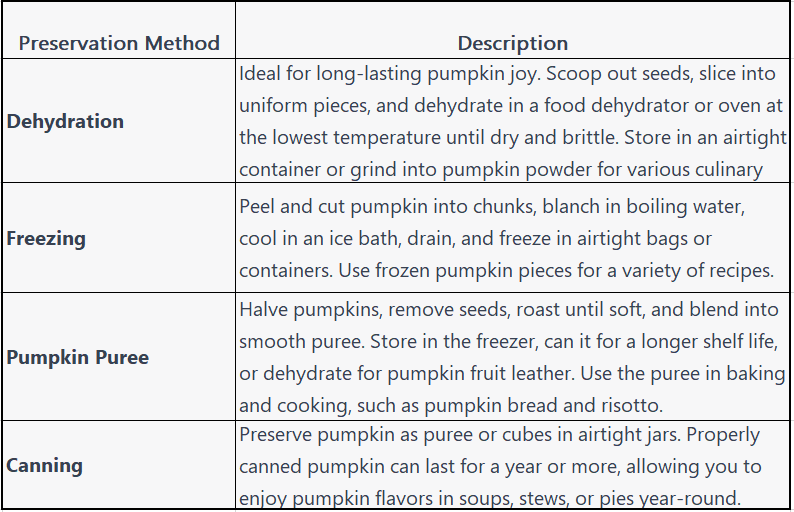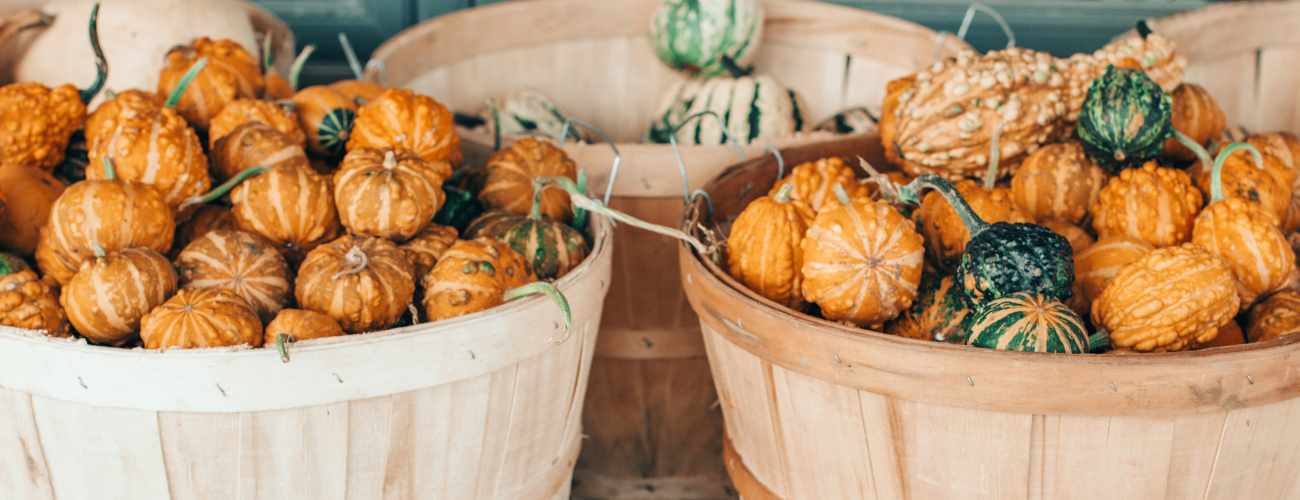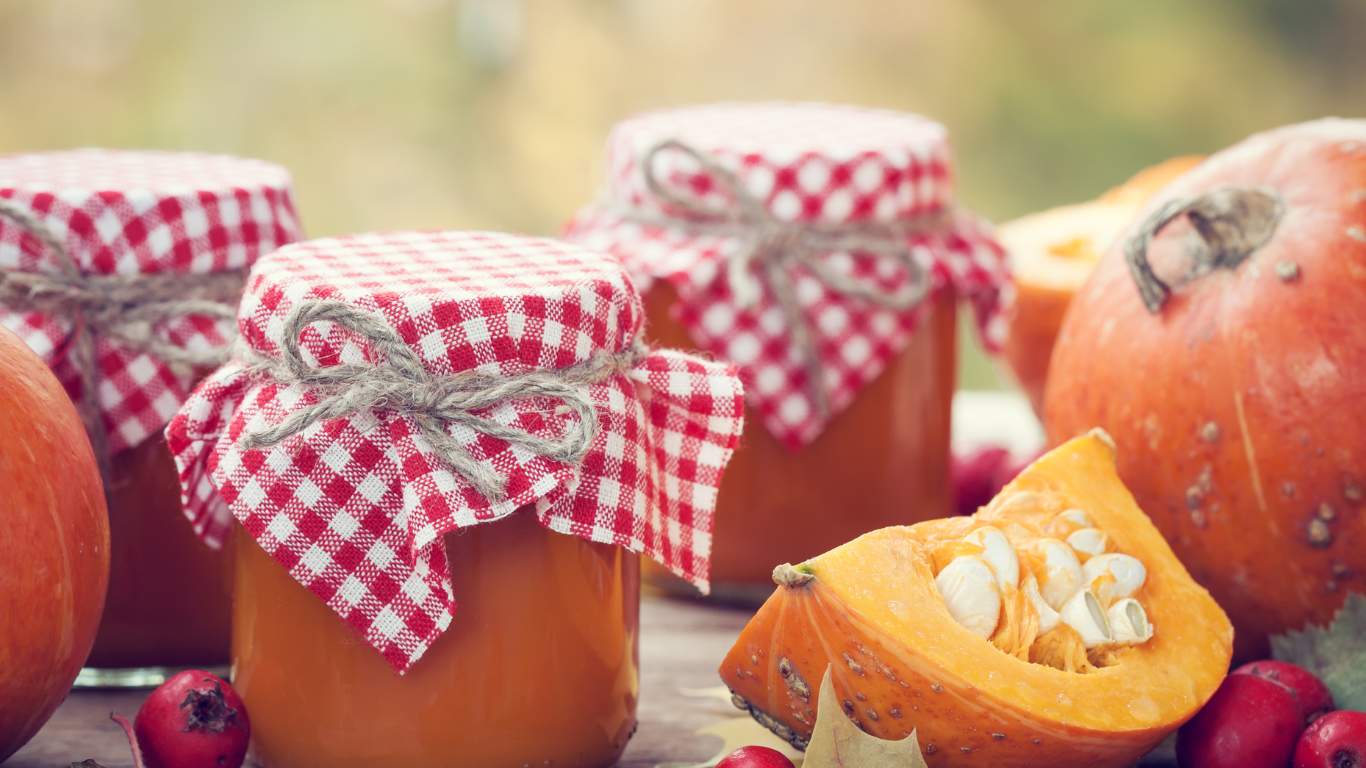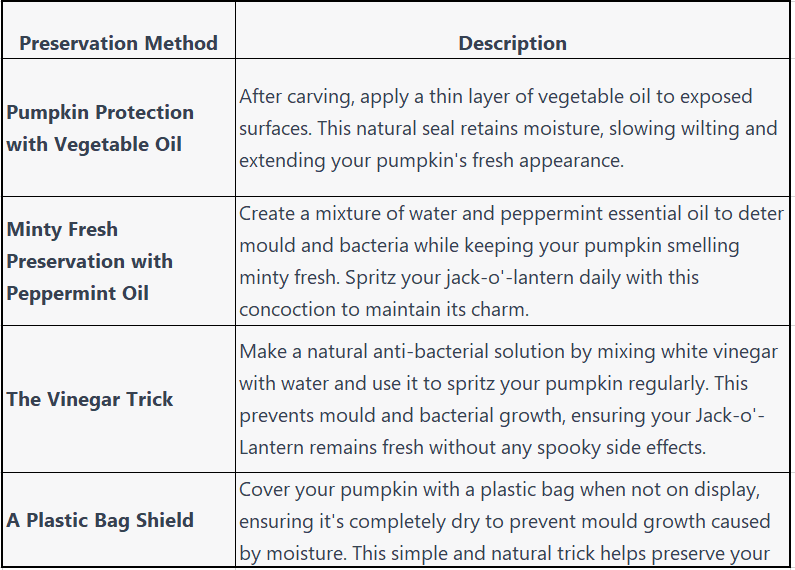As autumn rolls in, we are greeted by the cheerful presence of pumpkins. Keeping these vibrant beauties fresh turns into a fantastic family project. If you’re looking for the most natural ways to preserve your pumpkins, you’ve landed in just the right spot
The method of preserving pumpkins naturally can vary depending on your intended use. Dehydrating, making pumpkin-based products, and freezing are excellent options for long-term preservation. For shorter-term preservation, vinegar, oil, or peppermint solutions can help maintain their freshness.
Get ready to explore the world of preserving pumpkins in the most relaxed, eco-friendly way. Whether you’re aiming for long-lasting charm or just want your jack-o’-lanterns to stick around, we’ve got your back with a bunch of straightforward techniques.
Pumpkin Preservation to last the whole winter
Whether you picked your pumpkins from a local farm or grew them in your own garden, they bring a touch of magic to every family gathering. But what happens when you’ve amassed a delightful collection, and you want to make the most of this bountiful harvest? That’s where natural pumpkin preservation methods come to the rescue, allowing you to enjoy these vibrant beauties for an extended period.
1. Preserving Pumpkins by Dehydration
For families looking to make their pumpkin joy last throughout the year, dehydrating is a fantastic option. Not only does it extend the shelf life of pumpkins, but it also offers a world of culinary possibilities.
Start by scooping out the seeds and slicing the pumpkin into small, uniform pieces. These pieces are then dehydrated in a food dehydrator or your oven set to the lowest temperature, until they become dry and slightly brittle.
Once ready, you can store them in an airtight container for months or grind them into fine pumpkin powder, adding a burst of pumpkin flavour to your recipes. You can also dehydrate pumpkin puree to create delightful pumpkin fruit leather, a tasty and nutritious snack for the family.
These dehydrated pumpkin pieces can be rehydrated when you’re ready to use them, whether it’s for soups, stews, or even a mouth-watering pumpkin pie.
2. Freezing for Future Flavours
Freezing is another handy way to keep uncarved pumpkins fresh and ready for a future culinary adventure. To freeze your pumpkins, peel and cut them into small chunks, then blanch them in boiling water for a few minutes before transferring them to an ice bath to cool.
Once cooled, drain them and package the pumpkin pieces in airtight bags or containers, and pop them in the freezer. With this method, you’ll have a stash of pumpkin pieces ready to enhance your recipes, from creamy pumpkin soup to hearty casseroles.
3. Pumpkin Puree Pleasures
Pumpkin puree is a versatile addition to any family’s kitchen. To make it, cut your pumpkins in half, remove the seeds, and place them face-down on a baking sheet. Roast them in the oven until they’re soft and easily scooped out.
Blend the cooked pumpkin until it’s smooth. You can store it in the freezer for later use, can it for a longer shelf life, or even dehydrate it to create delightful pumpkin fruit leather, a tasty and nutritious snack for the family. This puree can be used to make delicious pumpkin bread, muffins, or even a mouth-watering pumpkin risotto.

4. Canning for the Long Haul
Canning is another fantastic method to preserve the goodness of pumpkins for an extended period. Pumpkin can be canned as a puree or as cubes. When canned properly, it can last for a year or more, ensuring that your family can enjoy the flavours of autumn well beyond the season. So, if you’re looking for a way to savour the essence of pumpkins in your soups, stews, or pies during the entire year, canning is your ideal choice.

I recommend you to read my blog on 3 best techniques for preserving your fruit naturally or on top 5 natural vegetable preservation methods to learn about if you are interested in how to preserve other fruits and veggies.
How to preserve a carved pumpkin?
A thin layer of vegetable oil to seal in moisture, a peppermint oil mixture to deter mould and bacteria, and a white vinegar solution to prevent bacterial growth are well-tested methods to preserve your Halloween pumpkin naturally. Keep your pumpkin fresh by storing it in a dry plastic bag when not on display.
Let’s dive into these methods of short-term preservation in more detail!
1. Pumpkin Protection with Vegetable Oil
Vegetable oil isn’t just for cooking; it’s also a wizard at preserving your pumpkin. After carving your masterpiece, apply a thin layer of vegetable oil to all the exposed surfaces. This natural seal locks in moisture and slows down the inevitable wilting process, keeping your pumpkin plump and fresh for a longer-lasting glow.
2. Minty Fresh Preservation with Peppermint Oil
For a hauntingly good way to preserve your pumpkin, whip up a concoction of water and a few drops of peppermint essential oil. This natural solution not only acts as a mould and bacteria deterrent but also keeps your pumpkin smelling minty fresh. Spritz your jack-o’-lantern with this mixture daily to maintain its charm.
3. The Vinegar Trick
White vinegar is a kitchen staple that can work wonders for pumpkin preservation. Mix one-part white vinegar with ten parts water to create a natural anti-bacterial solution. Use this concoction to spritz your pumpkin regularly. It prevents mould and bacterial growth, extending the life of your Jack-o’-Lantern without any spooky side effects.
4. A Plastic Bag Shield
To shield your pumpkin from outdoor elements naturally, consider covering it with a plastic bag when not on display. Ensure your pumpkin is completely dry before sealing it up, as moisture can lead to mould growth. This simple, natural trick can help preserve your pumpkin until Halloween night.
With these naturally wicked tips, your carved pumpkin will be ready to shine its light on Halloween night. No tricks, just natural treats – that’s what we’re all about when it comes to pumpkin preservation! 🎃👻

How long will an uncut pumpkin last?
The lifespan of uncut pumpkins generally ranges from 8 to 12 weeks, varying by variety; classic orange pumpkins last longer. A firm, blemish-free, and undamaged pumpkin lasts longer. Store it in a cool, dry place, away from direct sunlight and temperature fluctuations, like a garage, basement, or shaded porch.
Pumpkin Variety Matters
First on the list is the pumpkin variety. Some are naturally more long-lasting than others. A classic orange pumpkin typically holds up well, while the smaller sugar pumpkins are known to have a slightly shorter lifespan.
The Condition Is Key
The condition of your pumpkin also plays a role. Look for one that’s firm, unblemished, and free of soft spots. A healthy pumpkin is more likely to stand the test of time.
Here’s a tip that’s golden: don’t break the stem. The stem is like a pumpkin’s lifeline, and breaking it prematurely can age your pumpkin quicker. A healthy, attached stem is a sign of youth and vitality, so handle your pumpkin with care to keep it fresh.
The Right Storage
Where you keep your pumpkin can make a significant difference. Opt for a cool, dry spot away from direct sunlight and extreme temperature swings. The garage, a basement, or a shaded porch are all excellent choices.
Don’t forget to use the short-term natural preservation methods of vinegar, peppermint and vegetable oil, mentioned earlier on your uncut pumpkins too!





